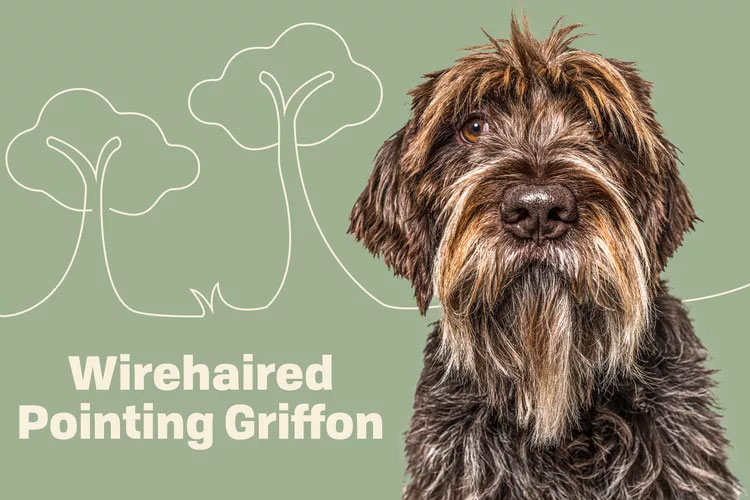
Wirehaired Pointing Griffon Overview
| OFFICIAL NAME | Wirehaired Pointing Griffon |
| COMMON NAME | Wirehaired Pointing Griffon |
| PET HEIGHT | 20 to 24 inches |
| PET WEIGHT | 35 to 70 pounds |
| LIFESPAN | 12 to 15 years |
| GOOD WITH | children, dogs, families |
| TEMPERAMENT | friendly, gentle, outgoing, playful |
| INTELLIGENCE | high |
| SHEDDING AMOUNT | infrequent |
| EXERCISE NEEDS | high |
| ENERGY LEVEL | active |
| VOCAL LEVEL | infrequent |
| DROOL AMOUNT | low |
| BREED GROUP | sporting |
| BREED SIZE | medium (26-60 lbs.) |
| COAT LENGTH | medium, wiry |
| COLORS | brown / chocolate / liver, gray |
| PATTERNS | bicolor, flecked / ticked / speckled |
| OTHER TRAITS | cold weather tolerant, easy to groom, easy to train, high prey drive, hot weather tolerant, loves water |
Wirehaired pointing griffons were bred as all-purpose hunting dogs but have since become a popular breed for those hunting for the perfect four-legged companion. With their scruffy appearance that's both distinctive and adorable, plus an up-for-anything temperament, WPGs are a sought-after family pet.
Although the wirehaired pointing griffon is a medium-sized breed (females are just 20–22 inches tall and weigh 35–50 pounds, while males are larger at 22–24 inches tall and weigh 50–70 pounds), these dogs have big exercise needs. Plan to spend lots of time walking, hiking, swimming, or engaged in fast-paced activities like rally and scent tracking.
In exchange for keeping their paws moving, wirehaired pointing griffons give lots of love, loyalty, and companionship.
Appearance
The wirehaired pointing griffon has a hallmark scruffiness that earns them a lot of attention. "Their moustache, beard, and bushy eyebrows give them their characteristic look," says Melanie Tuttle, vice president of the American Wirehaired Pointing Griffon Association.
"Griffs," as they're affectionately called, have a low-shedding double coat that's one of their most recognizable features: Their undercoats are soft, almost down-like, while their outercoats consist of medium-length straight and wiry hairs in shades of brown, chestnut, and gray. This fur sticks out in all directions, giving them an unkempt appearance. Their eyes, which are shades of brown or yellow, give the wirehaired pointing griffon a friendly, intelligent expression.
Their scruffiness is how you can tell wirehaired pointing griffons apart from the similar-looking German wirehaired pointers. Though both breeds have similar colorations and wiry hair, German wirehaired pointers have a thinner coat with a tidy mustache and beard. Griffons, on the other hand, have scruffy fur all over their face—basically, they look like a German wirehaired pointer who's badly in need of a haircut.
Temperament
Wirehaired pointing griffons are known for being friendly, loyal, and eager to please. "Griffs love being with people," Tuttle says. "They exude personality."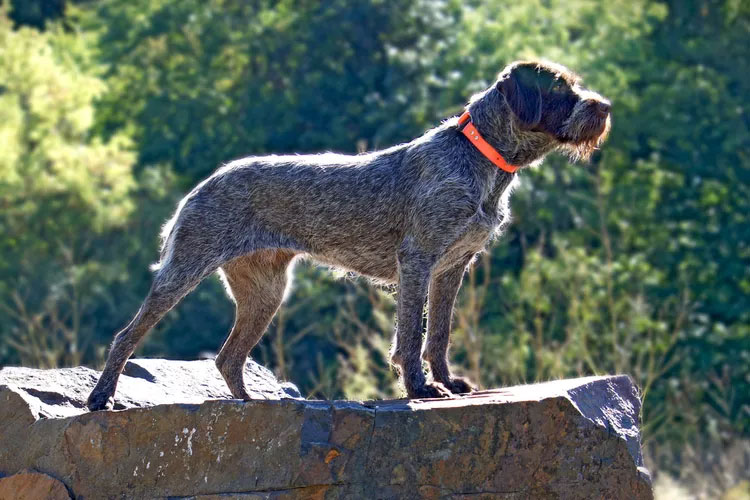
Griffs are happiest in active families where there are lots of opportunities to burn off their abundant energy. These sporting dogs are athletic and love to be on the go; wirehaired pointing griffons make excellent hiking or running buddies and often participate in dog sports such as obedience, rally, agility, and tracking.
"Just walking around the block on a leash isn't going to be enough for a griff," Tuttle says. "They need a place to get out and run."
Thanks to their easygoing personalities and up-for-anything attitudes, wirehaired pointing griffons love everyone they meet, from children to fellow dogs, and will happily bestow all who pass with affection and attention.
Living Needs
A well-exercised griff makes a great family pet. While some breeders and rescues insist that owners have large, fenced yards for wirehaired pointing griffons to play in, Tuttle believes the breed can thrive in apartments as long as there are lots of opportunities for hiking, swimming, fetch, and other activities that will burn off their energy."These dogs are not the right choice for people who want low-energy lap dogs," she says.
As much as wirehaired pointing griffons love outdoor play, they, like every dog breed, are not meant to live outdoors. Griffs, Tuttle says, develop strong bonds with their owners and want to be part of the family, whether tagging along on hikes or cuddling up for movie night.
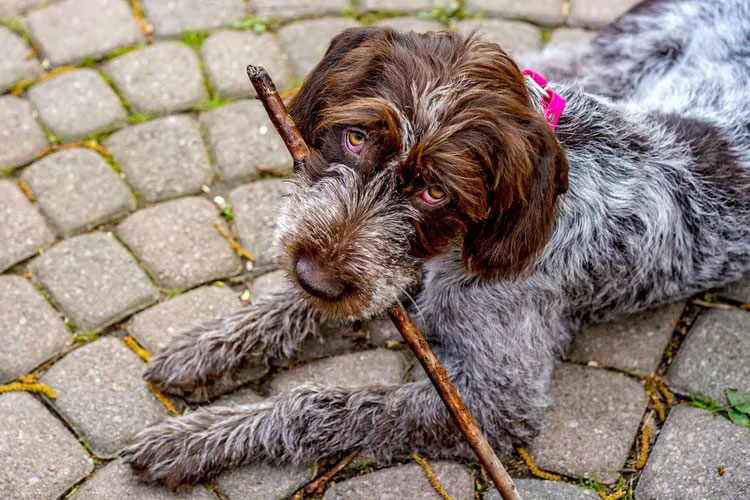
"This is a breed that wants to be with people and is meant to live in a home as part of a family," Tuttle says. "They make great family members; they are very loyal to their families."
And while wirehaired pointing griffons get along well with kiddos and other doggy friends, they were bred for hunting and may retain their prey drives. So, the breed may not be well-suited to homes with cats, rabbits, or other small pets.
Care
Wirehaired pointing griffons are considered a "wash and go" breed. Aside from an occasional bath and weekly brushing, their low-shedding coats are low-maintenance.But when it comes to exercise and training, Griffs are more demanding. Not only is regular physical exercise a must for the high-energy breed, wirehaired pointing griffons are also intelligent pups and need mental stimulation.
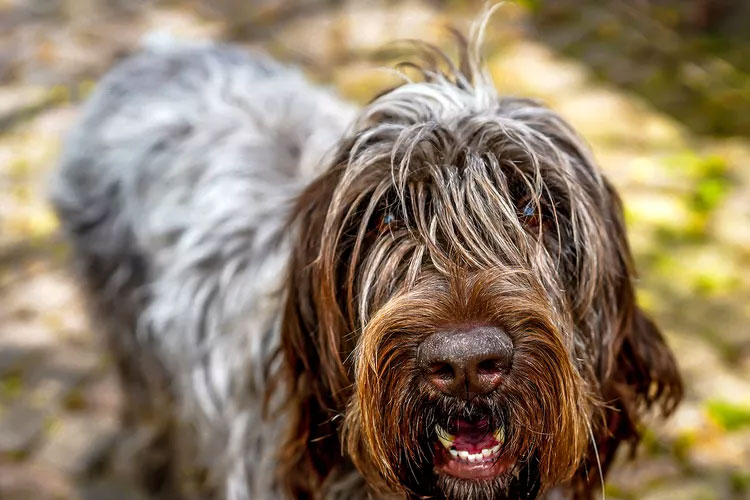
Activities such as fetch or long hikes with plenty of time to stop and sniff the surroundings are excellent outlets for wirehaired pointing griffons. After lengthy walks or romps at the park, offering puzzle toys can also help these smart dogs exercise their brains—but be sure to change up activities often.
"Griffs are very trainable, but they get bored quickly," Tuttle says.
Keep training sessions short, fast-paced, and varied to keep griffs from abandoning the teachings. As with all breeds, wirehaired pointing griffons respond best to positive reinforcement training and receiving rewards (like yummy treats) for a job well done. Competitions including obedience and hunt tests are another a way to provide wirehaired pointing griffons with both mental and physical stimulation.
Health
While the wirehaired pointing griffon has a lifespan of 12–14 years and is considered a healthy breed, the dogs, like all breeds, can experience some health issues.Hip or elbow dysplasia is a condition in which the joint of the hip or elbow doesn't fit into the socket, causing grinding and pain. Although hip and elbow dysplasia is more common in larger dogs, wirehaired pointing griffons can also be diagnosed with this. Treatments range from physical therapy and anti-inflammatory medications to surgery.
Griffons can also have eye problems. Issues like ectropion (a condition that causes the lower eyelid to roll outward, causing dry eye) and entropion (a rolling of the eyelid inward, triggering corneal ulcers and pain) can affect wirehaired pointing griffons.
Wirehaired pointing griffons are predisposed to Steroid Responsive Meningitis Arteritis (SRMA), says Karen Muñana, DVM, MS, DACVIM, professor of veterinary neurology at the North Carolina State University College of Veterinary Medicine. The neurological disease causes inflammation of the meninges, the fibrous membranes coating the brain and spinal cord, causing severe neck pain.
"We don't know the cause of SRMA," Muñana says. "We also don't understand why certain breeds [like the wirehaired pointing griffon] are predisposed, but the disease is likely influenced to some extent by genetics."
History
There is some debate over the wirehaired pointing griffon's origins. Eduard Korthals, a Dutch breeder and avid hunter, began developing the hunting dog in the late 1800s, according to the AWPGA. He crossed several hunting breeds in his quest to create the "ultimate walking hunter's gun dog," working in Germany and, later, France. This led to disagreements about whether the griffon is a Dutch or French breed.But there is unanimous agreement about one thing: The wirehaired pointing griffon is a well-rounded hunting dog that is adapted to hunting all species of game across varied terrain and climates.
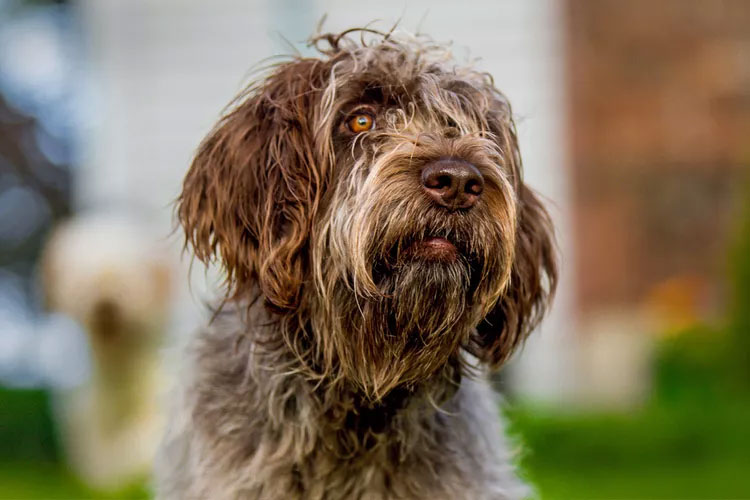
"It's a walking gentleman's hunting dog," Tuttle says. "It's a dog that can do it all. These dogs are capable of pointing and retrieving on land and in marshes; they also do water retrieves."
The wirehaired pointing griffon, long a favorite breed in France, is becoming more popular in the U.S. Tuttle isn't sure what contributed to the rising interest in the breed, but says one thing's for certain: "The secret is out."
Fun Facts
Prince Rainer III of Monaco owned a wirehaired pointing griffon named Odin. When the prince died, Odin walked behind the casket as part of the funeral procession.Wirehaired pointing griffons are known as "Korthols griffons" in some parts of the world, after the breed's developer.